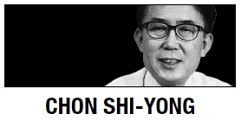Some years ago, I had lunch with an executive of the local unit of a global consulting firm. Rigidity, lack of creativity and the habit of dictating in Korean bureaucracy was one of the topics during the conversation.

He shared with me his own experience, as a member of a civilian advisory panel for a government ministry. The ministry consulted him and other civilian experts on a policy report to be presented to the president.
“The report was quite impressive. To be frank, I marveled at the competence of Korean government officials,” he said.
The awe quickly turned into disappointment. “I was shocked as much as I was marveled when I heard from my fellow member of the advisory panel that many things in the policy report were simply reproductions of the previous year’s report.”
Despite the passage of time and changes of administrations, the lack of innovative thinking among bureaucrats stands firm. All in all, old habits of Korean bureaucracy ― not least bad ones like complacency, rigidity and dictating ― die hard.
Evidence abounds, one of which is the way the Park Geun-hye administration operates the “centers for creative economy and innovation.”
Outposts for Park’s flagship “creative economy” policy, the centers now number 12 across the country. There will be five more, which means almost every major city and province in the country will have a center.
The basic concept of the government-initiated project is that the central and local governments work in conjunction with conglomerates to foster creative and innovative small firms in each city and province.
The centers will work with start-ups, venture firms, universities and research institutes to utilize their business ideas and technologies, with conglomerates providing assistance on things from legal affairs and finding investors to marketing and selling their products and services at home and abroad.
It is desirable for the government to facilitate collaboration between conglomerates and small firms, and nurture promising venture firms and start-ups ― which is one of the key elements of a creative economy.
But the way these projects unfold is never creative. Rather, it is nothing more than a typical case of “we lead, you follow,” as seen by the apparent “mobilization” of the nation’s top conglomerates.
Each of the conglomerates, including Samsung, Hyundai Motor Group, LG, SK and Lotte, has been allocated to one of the 17 centers, which have their respective specialized areas. For instance, Samsung provides its resources to the center in Daegu, which has been designated as a hub for electronics.
Likewise, Hyundai Motor Group is tied with the center in Gwangju, LG in North Chungcheong Province, SK in Daejeon and Lotte in Busan.
It is easy to see that these pairings have been dictated by the government. No Korean business would dare think twice about participating in a presidential pet project.
In fact, what prompted me to write this column is the almost identical opening ceremonies for the centers: Park, along with the tycoon whose company was called in, cuts the tape and makes a long speech, saying that it will be a locomotive of her creative economy by becoming a world-class hub of whatever specific industry the center has been assigned to excel at.
Her speech is followed by the tycoon’s pledge to provide active support for the center and the creative economy as a whole. Then the two, along with mayors, governors and other senior officials, tour the center, while Park beams contentedly.
The next morning, you will see a full-page advertisement about the opening of the center in the back page of major newspapers ― of course, courtesy of the conglomerate involved. Naturally, the back pages command some of the highest advertisement rates.
Park, who has faced criticisms that she did not engage properly during crises such as the Sewol ferry sinking and the current Middle East respiratory syndrome outbreak, has not missed one of the 12 opening ceremonies held so far.
Seeing the same, successive scenes in TV news got me recalling similar government mobilizations of business moguls like the one during the Chun Doo-hwan administration in the early 1980s.
After he seized power in a coup in 1979, the Army general-turned-strongman told Hyundai Group founder Chung Ju-yung to take charge of Seoul’s bid for 1988 Summer Olympics. The nation’s richest man accomplished the mission, as Seoul won the right to host the 1988 Olympics.
Chung went on to take over the presidency of the Korean Olympic Committee, and under the Chun administration’s guidelines, the head of each conglomerate was put in charge of individual federations.
The cause cited by the authoritarian government was simple: The conglomerates’ support ― a common euphemism for money ― was crucial for the successful hosting of the Olympic Games and for wining more medals in the Olympics while they were held in our own soil. For all the good cause, it was a typical case of government mobilizing and ordering businesses to engage in pet projects of political leaders.
Wikipedia defines a creative economy as a concept developed to describe economic systems where value is based on novel imaginative qualities rather than the traditional resources of land, labor and capital.
By all appearances, the pairing of conglomerates and the centers for creative economy and innovation, like the matchup of tycoons with sports federations in the 1980s, is far from imaginative. It only reminds us of the bad legacy of Korean bureaucracy and domineering presidents. It is uncomfortable to see a key project of the creative economy being implemented in a most uncreative way.
By Chon Shi-yong
Chon Shi-yong is the chief editorial writer of The Korea Herald. He can be reached at sychon@heraldcorp.com. ― Ed.



